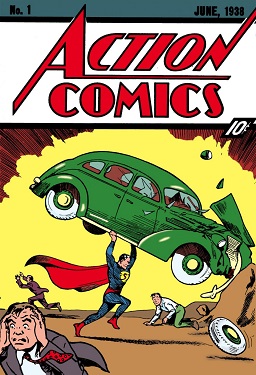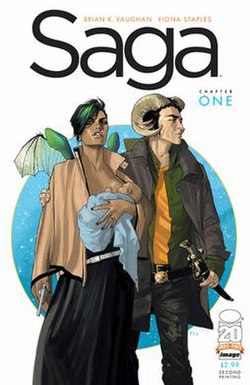Comics and Graphic Novels
Introduction
Sequential art is an art form that uses images deployed in sequence for graphic storytelling or to convey information. Sequential art predates contemporary comics by millennia. Some of the earliest examples are cave paintings, Egyptian hieroglyphics, and pre-Columbian American picture manuscripts, which were recurrent media of artistic expression.
Comics have played a huge part not only in the history of the United States, but really all of human history. For example, the earliest political cartoon in America helped communicate the colonies wish for independence in a way that incited a revolution. Another example of just how much comics have impacted our history is the Martin Luther King and the Montgomery Story comic, which is a 16-page comic book about Martin Luther King, Jr., Rosa Parks, and the Montgomery Bus Boycott published in 1957 by the Fellowship of Reconciliation (one of the oldest known interfaith peace organizations). It advocates the principles of nonviolence and provides a primer on nonviolent resistance.
Examples


Seminal Works
- Archie Comics
- Centaur Comics
- Amazing Man
- The Arrow
- The Clock
- Miss Fury
- Fantoman/Fantom of the Fair
- The Eye
- Speed Centaur
- DC Comics (aka National Allied Publications, National Comics, National Periodical Publications)
- Action Comics (Superman)
- All-American Comics (Green Lantern)
- All-Star Comics (Justice Society of America)
- Detective Comics (Batman)
- Flash Comics
- Leading Comics (The Seven Soldiers of Victory)
- More Fun Comics
- Aquaman
- Doctor Fate
- Doctor Occult
- Green Arrow
- The Spectre
- Superboy
- origin of The DCU
- Sensation Comics (Wonder Woman)
- Dell Comics
- The Owl
- Felix the Cat
- EC Comics (Tales from the Crypt)
- The early comic book issues of MAD.
- Fawcett Comics
- Whiz Comics (Captain Marvel)
- Fox Features Syndicate
- Mystery Men Comics (Blue Beetle, Green Mask, Samson)
- Phantom Lady
- Stardust the Super Wizard
- The Flame & Flame Girl
- Dynamo (formerly Electro)
- Thor
- Dr. Doom
- Wonder Man
- Fiction House
- Domino Lady
- Fantomah
- Starlight
- The Spirit
- Gem Comics
- Vampire
- Harvey Comics
- Golden Age Black Cat
- Captain Freedom
- Licensed The Green Hornet comics
- Lev-Gleason Publications
- Daredevil (later Daredevil & The Little Wise Guys)
- Crimebuster
- Jinx & 13
- Silverstreak (first speedster, predates Flash)
- Quality Comics
- Crack Comics (Black Condor)
- Feature Comics (Doll Man)
- Hit Comics (Red Bee)
- National Comics (Uncle Sam)
- Police Comics
- Smash Comics (The Ray)
- Standard Comics
- Better Publications
- Nedor Publishing
- Timely Comics (later known as Marvel Comics)
- Captain America Comics
- Marvel Comics
- Marvel Mystery Comics
- The Original/Android Human Torch: The first Marvel superhero alongside Namor the Sub-Mariner. Similar to but unrelated to the later and more famous Human Torch.
- Sub-Mariner
- Origin of the Marvel Universe
- Nelvana of the Northern Lights
- Amazing Spider-Man (most successful instance of the Marvel style)
- Fantastic Four (beginning of the modern Marvel Universe)
- The Flash (introduced the Alternate Universe to The DCU and in general exemplifies the age)
- Showcase (introduced updated versions of Golden Age heroes as well as popular new characters)
- Superman's Pal Jimmy Olsen and Superman's Girl Friend, Lois Lane (spinoffs from Superman and notable for their often bizarre plots and even more bizarre science. The former series is generally thought of by comic readers as the single most stereotypical example of Silver Age tropes, especially in modern Shout Outs.)
- The Incredible Hulk, first true anti-hero of that age, and arguably the last "monster comic" that Jack Kirby and Stan Lee did.
- Legion of Super-Heroes
- Jack Kirby's Fourth World cycle
- Howard the Duck
- film adaptation in 1986
- Green Lantern/Green Arrow
- Luke Cage: Hero for Hire
- X-Men
- The New Teen Titans
- Superman
- 2000 AD,
- Swamp Thing
- Camelot 3000
- Miracleman
- Secret Wars
- Heavy Metal
- Marvel's Conan the Barbarian
- Squadron Supreme
- Jonah Hex
- Daredevil
- Hellboy (1994)
- Venom
- Spawn (Image Comics )
- The Maxx
- Watchmen
- The Dark Knight Returns
- The Punisher
- Batman: Year One
- Other notable Dark Age Batman stories include The Killing Joke, A Death in the Family, The Long Halloween, and Knightfall.
- Wolverine
- Witchblade
- Judge Dredd
- Supreme
- Deathmate
- Body Bags
- Zero Hour
- Excalibur
- The Sandman
- Transformers: Generation 2
- Starman
- The Crow
- The Darkness
- X-Force
- Death's Head II
- Darkhawk
- Sonic the Hedgehog
- Stuck Rubber Baby
- Huntress
- Kingdom Come
- JLA
- All-Star Superman
- Ultimate Marvel
- Invincible
- Civil War
- Runaways
- 52 from DC Comics
- Identity Crisis
- Infinite Crisis
- Astro City
- Top 10
- Supreme
- Justice
- Green Lantern and Green Lantern Corps
- "war of light":
- Green Lantern: Rebirth
- The Sinestro Corps War
- Blackest Night
- "war of light":
- Annihilation
- Batwoman
- Irredeemable
- Star Wars Comic Book
- Gotham Central
- Spider-Man
- Rising Stars
- My Little Pony: Friendship Is Magic (IDW)
- Venom
- Vertigo Comics
- Archie Comics
- DC Rebirth
- Transformers
American Comic Book History
- The Golden Age (1938-1950)
- The Silver Age (1956-1970)
- The Bronze Age (1970-1985)
- The Dark Age (1980s- 2000)
- The Present (2000-Present)

Timeline of Events and Key Themes
- June 1938: Action Comics #1- Superman
- Originated the archetype of the superhero
- WWII
- Patriotic heroes
- War propaganda and racist portrayals of Japanese characters
- Cheap and disposable escapist entertainment that could be read and then discarded by the troops
- Late 1940s, the popularity of superhero comics waned
- Comic publishers diversified into genres such as war, Westerns, science fiction, romance, crime, and horror
- superhero titles were cancelled or converted to other genres
- Comic publishers diversified into genres such as war, Westerns, science fiction, romance, crime, and horror
- 1953 United States Senate Subcommittee on Juvenile Delinquency
- Alleged links between comic books and juvenile delinquency
- Comics Code Authority Established to enact self-censorship
- 1950s
- readership of comics was split 55% female and 45% male
- It was only when superhero comics were thrust into the mainstream that women lost their footing in comic history, many turning to underground comics to express their artistic inclinations.
Timeline of Events and Key Themes
- Silver Age (1960s- Early 1970s)
- Began with publication of Showcase #4 (1956)- The Flash
- Goofy, lighthearted and fantastic plots, Black and White Morality, and a general absence of mature themes
- Period of artistic advancement and commercial success in mainstream American comic books
- predominantly those in the superhero genre
- Revival of superhero genre following controversy
- DC comics 1955-1960
- Marvel comics revolutionized the medium
- Sophisticated stories and characterization
- time period of social upheaval and the rise of a youth counterculture
- Fantastic Four, Spider-man, X-men, Hulk
- Sophisticated stories and characterization
- Adaptation to TV
- January 1966, a live-action Batman (Adam West) television show debuted to high ratings

Timeline of Events and Key Themes
- Bronze Age (Early 1970s-mid-1980s)
- Social revolution fervor and post-Vietnam post-Watergate disillusionment
- Return of darker plot elements and more socially relevant storylines featuring real world issues
- Racism, drug use, alcoholism, urban poverty, environmental pollution
- Green Lantern, Green Arrow , X-men
- Racism, drug use, alcoholism, urban poverty, environmental pollution
- The Comics Code gradually loosened, letting morally ambiguous stories appear more often
- Swamp Thing, Ghost Rider, Tomb of Dracula
- Minority Superheroes & Female Leads
- Luke Cage, Storm, Blade and Monica Rambeau, John Stewart, Bronze Tiger, Black Lightning, Vixen, and Cyborg
- Invisible Woman, Hawkwoman, Dark Phoenix Saga, Gwen Stacey

Timeline of Events and Key Themes
- Dark Age (Late 1980s- 2000)
- Deconstruction of The Silver Age of Comic Books
- deliberate opposition
- Darker and edgier period featuring an increased focus on sex, violence and dark, gritty portrayals of the characters involved
- Creative Disputes resulted in new studios
- Dark Horse Comics (founded in 1986)
- Hellboy, Sincity
- Valiant Comics (founded in 1989)
- Image Comics
- Age's most influential content
- Creator owned
- Dark Horse Comics (founded in 1986)
- The portrayal of women
- plunged to ever more absurd depths, at times bordering on outright misogyny
- sub-genre of "Bad Girls" comics
- Deconstruction of The Silver Age of Comic Books

Timeline of Events and Key Themes
- Present Day (2000- Present)
- Decline of the comic book as a regularly published periodical
- Rise of the graphic novel as respectable reading material
- Non-superhero comics are becoming more mainstream
- Logicomix (which is about Bertrand Russel and the foundations of math) and Pride of Baghdad (which is about lions who escape from the zoo during the Iraq War)
- Result of Japanese popular culture imports
- Diversity and broadening demographics
- Hawkeye, Ms. Marvel (2014), Ultimate Spiderman, The Unbeatable Squirrel Girl, Gotham Academy, Saga, Thor
- Digital Comics & Trade Paperback
Notable Authors
Stan Lee
Frank Miller
Jack Kirby
Alan Moore
WIll Eisner
Steve Ditko
Mark Millar
John Byrne
Grant Morrison
Brian Michael Bendis
Neil Gaiman
Todd McFarlane
Brief History
Periodization Schemes in American Comic History
The development of the modern American comic book happened in stages. American historians generally divide 20th-century American comics history chronologically into ages:
- Golden Age: 1938 (first appearance of Superman) to 1954 (introduction of the Comics Code)
- Silver Age: 1956 to early 1970s
- Bronze Age: 1970s to 1986
- Modern Age:1986 until today
Note: Not all scholars and fans apply this same periodization scheme. Furthermore, the dates selected may vary depending on the authors (there are at least four dates to mark the end of the Bronze Age). This is intended to be a basic guideline for cultural and social shifts in the production and consumption of comics. In this guide, the Modern Age is broken up into the Dark Age, and Present Day, in order to highlight important collections and themes.
-
A Complete History of American Comic Books by Shirrel Rhoades
ISBN: 1433101106 -
Super-history: comic book superheroes and American society, 1938 to the present by Jeffrey K. Johnson
ISBN: 9780786465644 -
Of Comics and Men by Jean-Paul Gabilliet
ISBN: 9781604732672